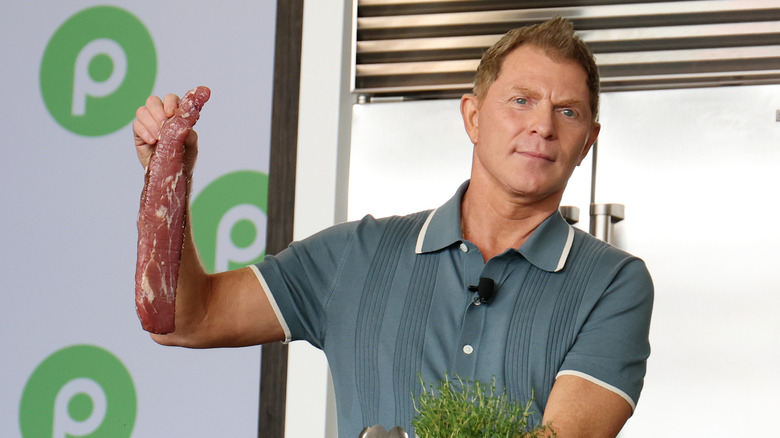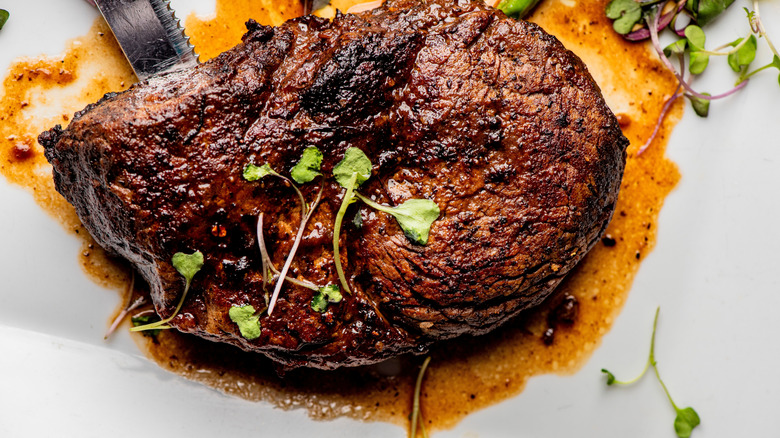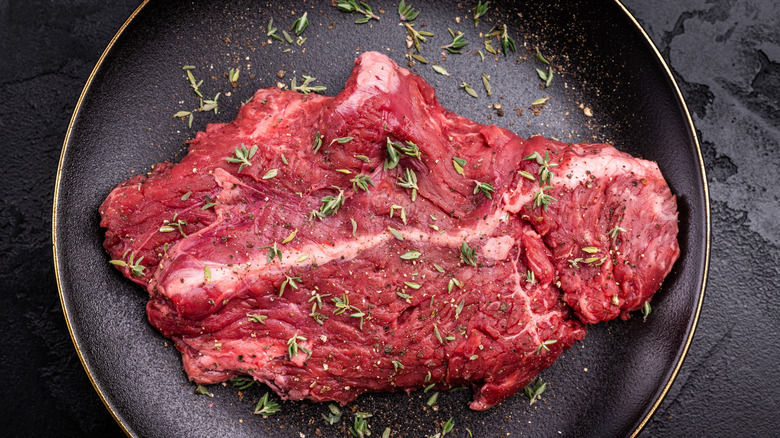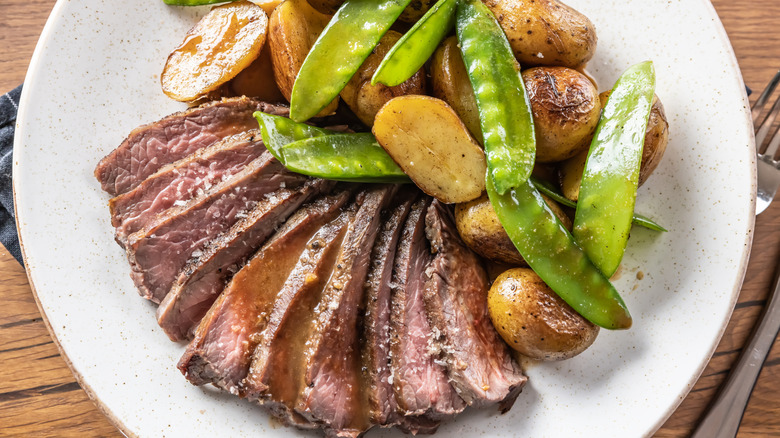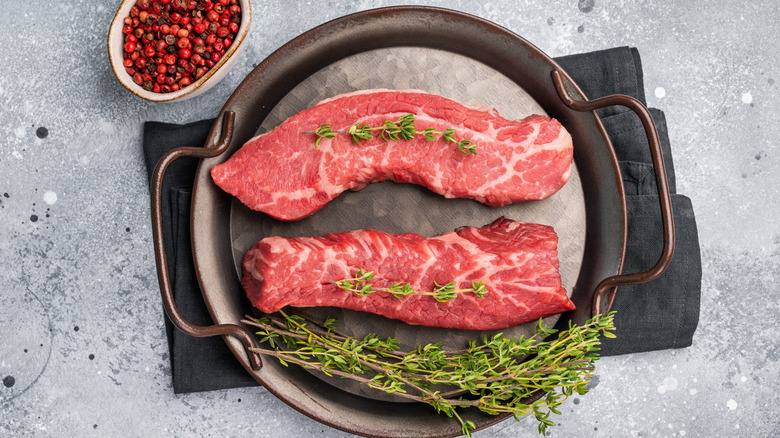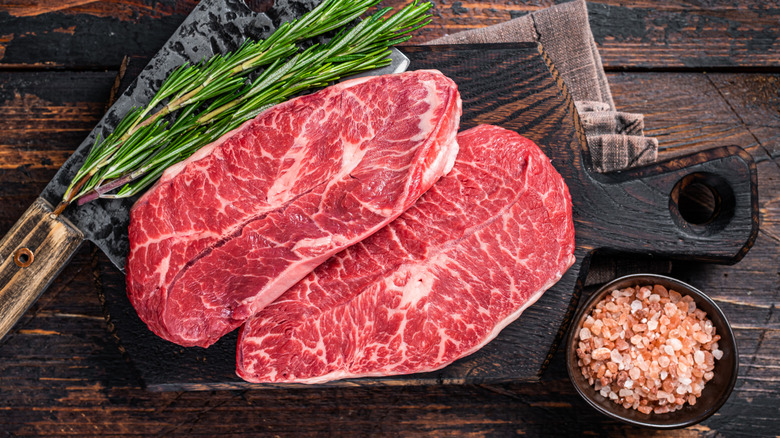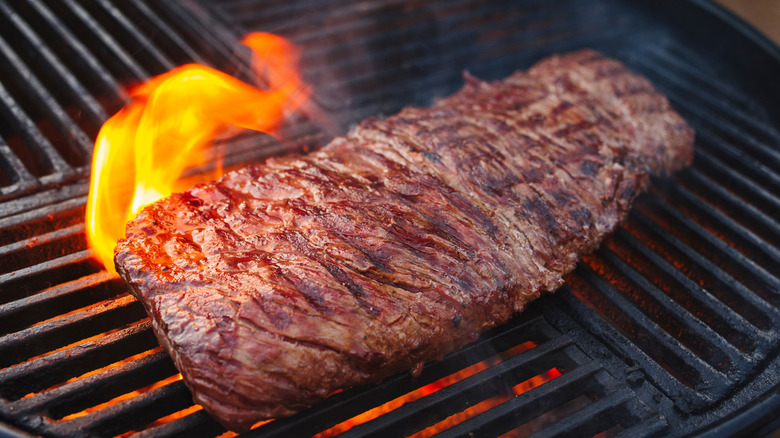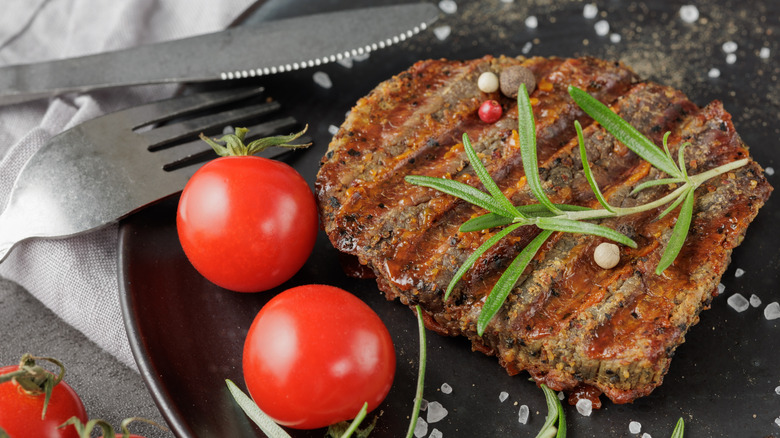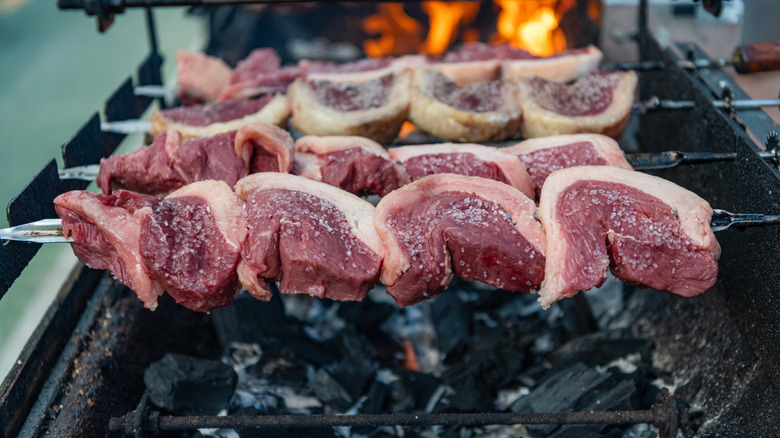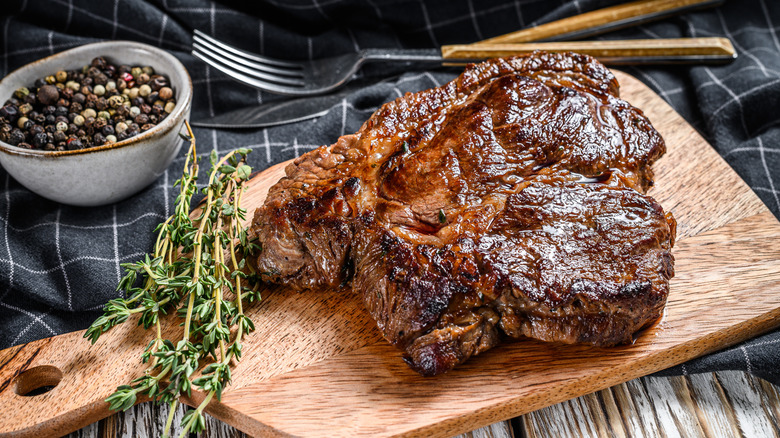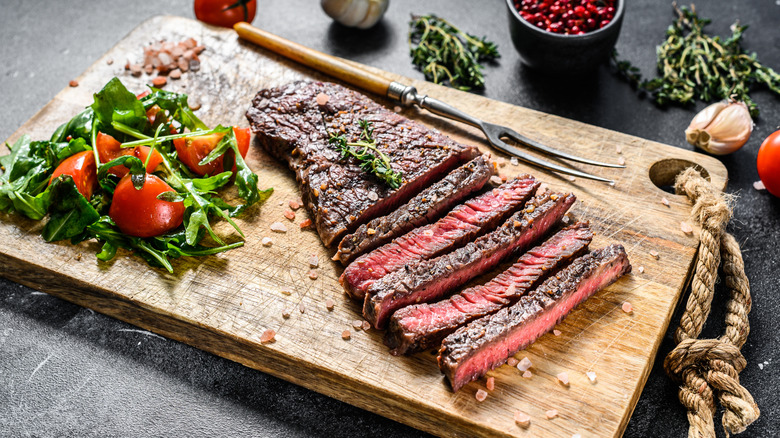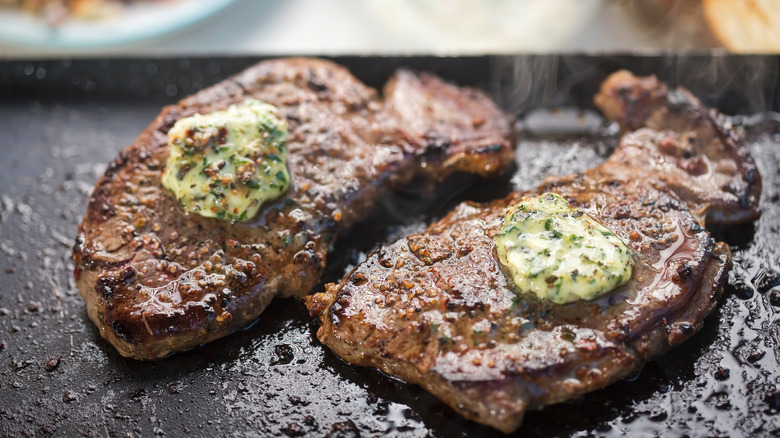11 Budget-Friendly Steaks Celebrity Chefs Love To Cook
Steak is a beloved dish enjoyed by many, including celebrity chefs who have mastered the art of cooking the perfect steak dinner. Even though grilling thick steaks evenly is no longer a mystery, many people still shy away from budget-friendly cuts, thinking they won't taste as good or cook well. We're here to tell you that it's all about technique. While fancy cuts of meat are used to make sure the end result is nothing short of amazing, chefs have figured out ways of making even the cheapest cuts the star of the show.
These celebrity chefs prove that steak doesn't have to be a luxurious Wagyu or a succulent tomahawk to be delicious — with skill and creativity, any cut can go from zero to hero in no time. We know how these celebrity chefs like to order their steak — now let's dive into the budget-friendly cuts they love to cook. From lean cuts that soak up marinades to naturally tender options that shine with simple seasonings, these underrated steaks offer incredible value without sacrificing flavor. Besides, learning how to cook with more affordable cuts of steak will help you become a more versatile and confident cook.
So, if you've been sticking to the same pricey cuts at the expense of your budget, it's time to rethink your steak game. The next time you're at the butcher or grocery store, keep an open mind, and maybe a little space on your grill for these delicious, celebrity chef-approved picks.
1. Skirt steak
The skirt steak is a long, flat, and very flavorful cut of meat that Gordon Ramsay uses to make an affordable steak dinner that is great for a date night or just a dinner with friends. Although he agrees that skirt steaks don't look appetizing in their raw form, they are really delicious once cooked. Ramsay likes to let the steak rest a bit before he begins marinating it, and then let the marinated steak sit for 10 to 15 minutes before he begins cooking. For a great marinade he adds olive oil, kosher salt, freshly ground black pepper, garlic, fresh rosemary, fresh thyme, and butter to the skirt steak.
The steak has to come to room temperature before cooking it for it to cook more evenly. Next up, Ramsay adds a splash of olive oil and some lightly crushed garlic to a hot pan, then sears the steak over high heat, carefully avoiding overcooking. He goes on to add fresh herbs to his pan and places the steak on top of the herbs, which prevents it from burning on the outside while it continues to cook on the inside. The result is a juicy and succulent skirt steak that will have you forgetting about a T-bone.
2. Hanger steak
While some people have really underrated this cut of steak, Bobby Flay believes it has a wonderful flavor and just has to be cooked right. He asserts that a hanger steak can be cooked in so many different ways, making it both affordable and versatile. Because it is so flavorful and tender, Flay calls it the Butcher's filet. He starts off with a spice rub consisting of cumin, mustard powder, coriander, paprika, ground fennel, a touch of brown sugar, salt, and black pepper, and mixes it all up. Next, Flay adds avocado or canola oil to the steak and gently rubs in the spice mixture. As is the norm, the steak is then left to rest for a few minutes as it absorbs the spices. He usually uses this time to prep the sides for the meal. Then, he grills it to perfection.
The late chef Anthony Bourdain also enjoyed cooking hanger steak. He loved the fact that the steak was not too tender and not too rough, and described it as having an almost kidney-like taste. Although his first impression of hanger steak was that it was both intimidating and exciting, he eventually declared that true dining begins with this cut. Add some fries and a glass of wine on the side, and the chef believed those were the keys to living the good life.
3. Flank steak
Guy Fieri loves this cut, referring to his go-to recipe as a Zing Zang flank steak. While most people will just season the steak and add it to a hot grill or fry it, Fieri prefers to butterfly it, as you would cut a chicken breast before stuffing it. Then the chef adds sauteed onions and Calabrian peppers. He believes that sauteing the vegetables in advance helps prevent overcooking the steak, since you're not waiting on them to cook through. Next, he adds raw tomatoes and tops them with panko bread crumbs to absorb the juices and flavor. Then comes a generous scoop of grated mozzarella cheese followed by basil leaves. Finally, Fieri folds the steak over and secures the stuffing in place with skewers. For those looking to avoid last-minute stress, the celebrity chef recommends prepping the steak a day ahead, so when it's nearly time to serve, you just have to pop it into a hot pan and cook. It's a bold, flavor-packed twist on flank steak — classic Guy Fieri style.
Michael Symon is another celebrity chef who loves to cook flank steak, though his preferred method is to grill it and serve it with a pepper relish. He marinates it with soy sauce, mustard, and brown sugar for an hour or so before he starts cooking. He recommends cooking the steak really slowly and leaving room for the caramelization to happen at a steady pace. The results are a steak that's simply delicious.
4. Tri-tip steak
Andrew Zimmern's go-to for juicy, budget-friendly grilling is a tri-tip steak. In an exclusive interview with Mashed where he dishes on "Family Dinner" and "Bizarre Foods," two shows he hosts, Zimmern notes that tri-tip is one of the most flavorful and delicious cuts of steak. It just has to come from an animal that's preferably mainly grass fed and sourced from a good butcher. This will result in a well-marbled steak — just the way Zimmern likes it. Tri-tip comes from the bottom sirloin part of the animal and is often overlooked in favor of trendier cuts, like porterhouses and New York strips, but Zimmern sees it as a hidden gem with superb value.
He explains that because it's lean with just the right amount of fat, it cooks beautifully on a grill or in a cast iron skillet. To get the most out of it, he recommends seasoning it generously and cooking it to medium-rare for optimal juiciness. Tri-tip is a great option for feeding a crowd without breaking the bank, and perfect for those who want rich, beefy flavor on a budget. For Zimmern, it's proof that you don't need a premium cut to serve a steak that's memorable — you just need to cook it right.
5. Flat iron steak
Flat iron steaks come from the cow's shoulder or chuck area and are very tender and flavorful. Jamie Oliver calls this one of his favorite steaks and views it as a secret weapon, easily surpassing sirloin, ribeye, rump, and filet. In fact, he would take it over a filet any day of the week. Oliver believes that the sinews found on the side of the steak make it less popular, but they can easily be removed by any butcher, so there is no reason to shy away from this cut. To cook the steak, Oliver first rubs olive oil all over it as he heats a thick bottomed pan on very high heat.
"Heavy on the pepper and heavy on the salt” is his mantra when marinating this steak, ensuring it soaks up as much flavor as possible. He then places the meat in a hot pan, cooking it for a total of six minutes and flipping it every minute to ensure an even sear on both sides. Between flips, Oliver rubs in garlic cloves, butter, and thyme, adding them one at a time to build layers of flavor. The result is a succulent, mouthwatering steak that'll have you rushing to your local butcher for more — especially since it's easy on the wallet too.
6. Bavette steak
Kristen Kish brings out the best in this rich, bistro-style cut, with its gorgeous marbling that produces a delightful flavor that basically melts in your mouth as you eat it. Sourced from the abdominal muscles of the cow, bavette — also referred to as flap steak — is known for its loose texture and deep, beefy flavor. Kish enjoys cooking this well-marbled steak and usually starts off by trimming the fat surrounds. However, she doesn't throw away the fat trimmings, and instead adds them to a saucepan and renders them at high heat. This results in plenty of flavor which can be used to enhance side dishes such as potatoes.
Kish loves the fact that bavette is basically a one-stop-shop for everyone in the family, since it's a large cut of steak that is usually uneven. This basically means that after grilling it, there will be parts of the steak that are well done, medium rare, and rare. It doesn't get more convenient than that, saving you a lot of time since you don't need to cook everyone's steak individually. Just pop it on the grill and you're done. Kish loves to serve her grilled bavette with a crushed olive and herb sauce, along with a sweetcorn, snap pea, and smoked yogurt salad.
7. Eye-of-round steak
The eye-of-round steak is lean and looks like a tenderloin, but it is much less tender since it comes from a muscular part of the cow. Tim Clowers makes this lean cut of steak work for any meal. He especially loves using it for roasts, as the lean cut soaks up all the rich flavors from the sauce. His go-to ingredients for the marinade are salt, pepper, onion powder, garlic powder, paprika, dry mustard, and chili powder. No complaints from us, as that combination would leave anyone drooling. The steak has to be seasoned very heavily on both sides before it is placed in the oven at 350 degrees Fahrenheit for an hour.
While he waits for his roast, Clowers preps onion, celery stalks, carrots, and bay leaves, and combines them with beef broth. After the hour is up, he pours his mixture over the steak, covers it in foil and places it back in the oven to cook for an additional two hours at 300 degrees Fahrenheit. Clowers recommends draining the steak from the broth and allowing it to rest for 15 minutes before you cut it up. The steak might look dry but he assures us that it will be very tender, very juicy, and very flavorful. We would definitely want a bite of that.
8. Picanha steak
This inexpensive cut of steak is a hit in Brazilian barbecue, boasting plenty of intramuscular fat which makes it flavorful and tender. It also happens to be Gustavo Tosta aka Guga's favorite cut. He says the picanha, which is also known as the queen of all meats, is a steak that has a special place in his heart. This steak also has quite a lot of fat surrounding it that needs to be trimmed before cooking. When prepping this cut, Guga carefully trims off the silvery membrane, making sure to preserve as much of the meat as possible in the process. After trimming and cutting the steak to perfection, Guga seasons it, preferring a traditional method using only salt. He also likes to season the fat, which is something not a lot of people do.
When the steak has been seasoned and given time to rest, Guga bastes it with butter. He loves to use real butter because the milk solids produce a nutty flavor as they cook that is undeniably delicious. Guga prefers to cook his picanha outdoors over a charcoal grill, positioning the fatty side of the steak over the cooler part of the grill. He also prioritizes getting a perfect sear — the most important part of the process, in his opinion. When the steak is done, Guga bastes it in butter again and lets it rest before cutting. He says the picanha is his favorite cut for one simple reason — it's delicious.
9. Chuck-eye steak
Martha Stewart loves this cut of steak because of the nostalgic memories she associates with it — and because it is delicious. The chuck-eye steak is a very underrated cut that will bring you a lot of satisfaction if given the chance. Beef experts believe that chuck-eye steak deserves a lot more credit than it gets. Well, it turns out Martha Stewart agrees. She loves it not just for its rich flavor, but also because it's perfect for making pot roast — a budget-friendly dish that leaves you with plenty of leftovers.
To start, Stewart seasons and browns the steak to give it a nice color for when it is ready to be served. Then, she removes it from the pot and adds in onions, thyme, bay leaves, peppercorn, carrots, and celery and lightly sautes them for a few minutes before adding in the flour, water, and red wine vinegar. She then adds back the meat and cooks it for two to three hours until it is tender and ready to be devoured. This method has us licking our lips just at the thought of it.
10. Denver steak
This cut of steak is sourced from a muscle that is located beneath the shoulder blade of a cow. Brooke Williamson loves to cook Denver steaks as she celebrates the warm weather and fresh spring flavors. Her go-to chili rub ingredients include avocado oil, minced garlic cloves, Fresno chili peppers, Korean chili flakes, Korean chlli paste, brown sugar, and chili powder. Williamson seasons her Denver steak with the rub and places it in the fridge for four to six hours or overnight, so that the meat absorbs as much flavor as possible.
When it's time to cook, Williamson sears the steak to lock in all those bold, spicy flavors, then finishes it off with a dollop of her homemade miso-lemon butter for a very rich, umami-packed finish. It's a perfect example of how a humble cut can be elevated into something truly memorable with the right technique and ingredients.
11. Ranch steak
Aside from the tragic details of cowboy Kent Rollins life, we know that the ranch steak is a cut of meat that brings light and joy to his life as he really enjoys cooking with it. It's a win-win since Rollins also brings his cowboy charm to this humble, affordable, and underrated cut. He begins by trimming the excess fat from the steak for a cleaner, neater presentation, then gives it a flavorful smoke bath using a touch of cherrywood. Instead of finishing it on the grill, Rollins opts to sear the ranch steak on a hot cast iron skillet, which helps to intensify its natural, hearty flavor.
He believes that although the ranch steak is a tougher cut of meat, if you treat it right, it will be your Sunday dinner every week. His secret to cooking this steak is to simply take your time with it, and the results will be something that cookbook fairy tales are made of.
